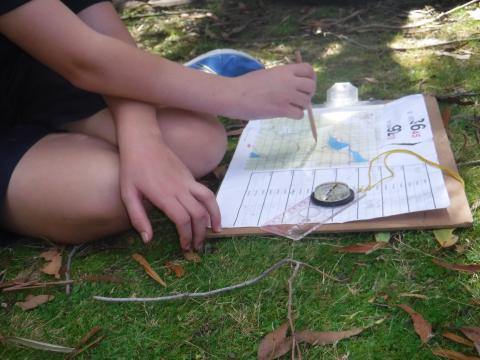
Year 5/6
Grade 5/6 programs are more flexible, and have the option of being delivered in two parts – an introductory classroom lesson, and a hands on field based experience.
In the classroom FEF can introduce the concepts of different forest types, how forest ecosystems work and the adaptation of plants to these systems. Students then learn to use more detailed maps, and are challenged to collect accurate GPS coordinates of some of the school features.
Following this the field trip provides an opportunity to develop the students forest interpretation and mapping skills as we explore a local area – for southern schools we venture into the forests surrounding the Waterworks Reserve and for northern schools we explore the Hollybank Reserve.
Curriculum Links
Science
Living things have structural features and adaptations that help them to survive in their environment. (ACSSU043)
- Exploring eucalypt adaptations – leaf structure, bark, epicormic buds and lignotubers, using samples and images to illustrate the adaptations.
- Identifying adaptations of understorey plants to low light levels and to dry conditions, using samples collected from different forest types.
The growth and survival of living things are affected by the physical conditions of their environment. (ACSSU094)
HASS
The environmental and human influences on the location and characteristics of a place and the management of spaces within them (ACHASSK113)
The impact of bushfires or floods on environments and communities, and how people can respond (ACHASSK114)
- Understanding how fire behaves in a range of habitats and landscapes, including fire frequency and intensity.
- Understanding how the natural environment responds to fire (regeneration).
- Exploring ways in which people and communities respond to the impact of fire, and how this can be influenced by understanding natural processes.
- Explore the application of science and research in fire management.
Organise and represent data in a range of formats including tables, graphs and large- and small-scale maps, using discipline-appropriate conventions. (ACHASSI096 and ACHASSI124)
- Students annotate basic map to locate natural and man-made features of a site. Use compasses and measuring equipment to identify reference points and a sense of scale.
Design and Technology
Examine how people in design and technologies occupations address competing considerations, including sustainability in the design of products, services, and environments for current and future use (ACTDEK019)
- Explore the ways that people interact with forest landscapes and the implications for forest biodiversity.
- Investigate the ways scientists research forest systems for sustainable forest management.
- Search for tree hollows and understand the implications of hollow dwelling animals for forest management.
- Understand the different ways that people interact with forests in their careers.
Investigate food and fibre production and food technologies used in modern and traditional societies (ACTDEK012)
- Explore the ways in which timber is used in our daily lives.
- Follow the story of paper from nursery site, plantation coop, and forest management to research and export guidelines.
Investigate the suitability of materials, systems, components, tools and equipment for a range of purposes (ACTDEK013)
Coming soon! A new resource to take back to school after your field experience. An open ended and innovative wood product to explore the design phases.
Thank you for choosing to explore the forest with a Forest Education Foundation excursion. You will find everything you need to know to plan and pack for your trip. Please ensure you have completed the Excursion Acknowledgement/Medical Information form at least 3 days PRIOR to your excursion.
- What is the purpose of your field trip? We can develop your program to suit your learning objectives and meet your curriculum needs. Please let us know anyway we can adapt the program to suit your students’ interest and learning needs.
- Please notify us about any student with special needs. We can adjust your program to ensure everyone is involved.
- Take advantage of our bus subsidy and fill your bus. Why not take two classes? The FEF has two teachers so taking two groups is not a problem, depending on the program.
- In order to make your excursion planning easier the FEF has developed a Risk Assessment Plan. This document is written by the qualified teachers of the FEF. For a copy of the risk assessment document click here.
- Bring along parent helpers. Extra assistance is always appreciated. We will get any parent helpers actively involved in the program.
- Organise your students into small groups 4-6 groups depending on the class size.
- Ensure your students are supervised at all times.
- Prepare for all-weather possibility. Ensure your student have warm clothes, comfy shoes and wet weather gear.
Have fun! The forest is an amazing place. Get involved and enjoy the adventure with your students.
The Year 5/6 program costs $200 per class for school in the North and $250 for Southern school, which also includes a class visit.
An invoice will be sent to the school following your excursion. School groups using externally hired transport may apply for a $100 bus subsidy.
- What do you know about forests?
- Are all forests the same?
- List the ways in which trees in a forest depend on the other parts of the forest ecosystem.
- Discuss how people interact with the forests.
- What are the features of a eucalypt tree that help it adapt to its conditions?
- Compose a ‘before’ and ‘after’ poem or artwork that explores a forest fire and the new life and regeneration that follows.

